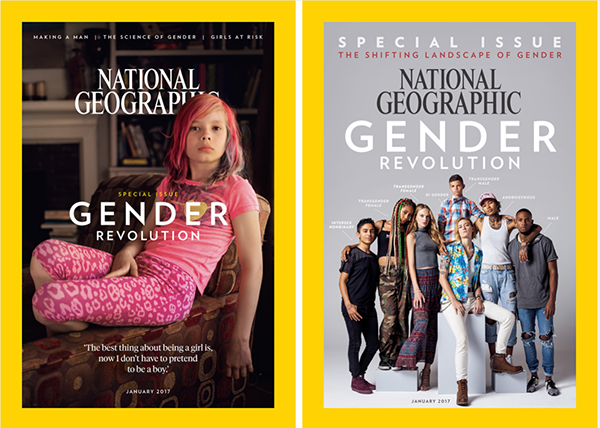The Gender Revolution and Equality
I just finished reading an enlightening special issue of National Geographic on Gender Revolution.
Here are a few things I learned that apply to how we treat each other at work:
- Not everybody is wired the way you would like them to be, which can make this an uncomfortable conversation.
- Women have been and continue to be in struggle for equality with men.
- Many people who are “different” have a biological reason for being that way. It’s who they are. There should be no reason that people must hide who they are because of your judgment about them.
- Research suggests that gender is something we are born with: it can’t be changed by any interventions. Like gender identity, it is difficult to change sexual orientation.
- There is a new vocabulary around gender today which is foreign to most. If we wish to be inclusive it is helpful to understand that vocabulary. For example terms like gender fluid, gender queer, intersex, non-binary, transgender, agender and transsexual.
- Many gender non-conforming children and adults are at risk for bullying and mental health problems.
- Gender comes with its stereotypes, reinforced at a young age. For example while men are often complimented related to their skills, women often complimented related to their appearance.
- There are also great gender disparities in terms of health, education, economic participation and political participation.
- In terms of our gender gap, the United States is ranked #24 out of 109 nations.
When I train on diversity and inclusion, I talk about the four levels of human interaction.
Fear – there are times when fear is a legitimate response to a perceived threat. However this is often born out of ignorance and not reality. Why else would we fear someone who differs from us and intends us no harm?
Tolerance – this is the “do no harm” standard imposed by the law. It is the ground floor of responsibility.
Acceptance – acceptance comes with awareness. It is hard to jam acceptance downs somebody’s throat. Dialogue, interaction, shared stories, celebrating differences. These things build acceptance.
Unconditional love – as preached by Jesus, Buddha and others this is the realization we are all one and interconnected despite our differences. Love your neighbor as yourself. This does not mean you must have unconditional relationships with people.
There are times I am less than accepting or loving than I’d like to be. Often that is when I have my own stress or fear going on. When I am not accepting or loving myself properly. It’s hard to give what you don’t have.
Sometimes we have to push ourselves into uncomfortable positions so we can get our fears and non-sense out of the way. Years ago I went to a 10-day Tony Robbins program in Hawaii. On the first day he left a thousand participants to roam around and find a partner they would work with for the next 10 days. My first and natural reaction was to find a guy just like me. But then it hit me I was there for growth and I sought the person who looks least like me. And I met Beth, a very heavy, very pale, out of shape woman from Los Angeles. And then I learned about the beauty of Beth. About her struggles and fears. I was humiliated and humbled in the process. It was a life changing experience. In the course of 10 days I was able to move from fear to tolerance to acceptance to unconditionally loving Beth for who she is.
Now I purposely seek out different people because I know it will be a growth experience. And you can do that too.
You can learn more about the Gender Revolution here.
Here’s to a more accepting and loving 2017, Don
PS now is the time you must update your compliance posters. Please go to my favorite poster vendor.

